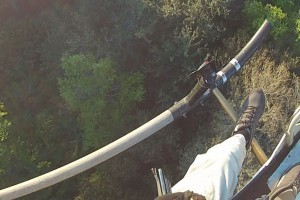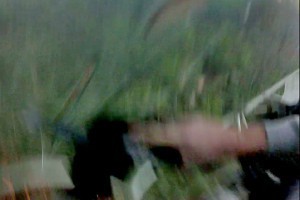LESSON FROM A HELICOPTER CRASH
In the blog entry below this, you’ll see a retrospective on a helicopter crash a couple of years ago, with links to discussions on it at the time. You’ll also find what we didn’t have then: the Go-Pro camera’s recording of the crash, and how quickly and unexpectedly it happened.
A profound lesson from it relates to the third of the now-standard Four Rules of Firearms Safety created long ago by the late Col. Jeff Cooper – so long ago, apparently, that some today neglect to give Cooper credit for creating them.
Rule Three was to keep the finger off the trigger until one’s gunsights were on target. Today we go a little more depth into that; I for one teach it as “Keep the finger outside the trigger guard until you are in the very act of intentionally discharging the weapon.” In any sort of moving vehicle, that’s all the more critical…and in a small helicopter aloft in the wind, it’s even more so.
When the aircraft went down, there were three fully loaded hunting handguns on board, two of them holstered; only John Strayer’s was drawn. He was the one who had spotted the first quarry of what none of us could have known was going to be a shorter day of hunting than we expected, and his gun was appropriately drawn and ready. It was a Smith & Wesson Model 29 Mountain Gun, a relatively lightweight .44 Magnum loaded with powerful, deep-penetrating hunting ammo. Powerful enough that if it had unintentionally discharged in the wrong direction, it was totally capable of killing both the man on his immediate right (the pilot) and the man to his right, which would have been me.
It was John who was wearing the Go-Pro camera, and if you look closely, as the Hiller was coming over the copse of trees looking for the hog he had spotted, there’s an instant where he glances down and the camera catches his .44.
You can see that the double-action revolver is in his right hand. The hammer has not been cocked. His gloved left hand (it was cold in that open-side-cockpit helicopter on a January morning, even in Florida, with the wind coming through) is securing the gun in place, grasping it around frame and cylinder.
Then, the rotors hit the trees and the aircraft went down. (Helicopters, it turns out, don’t have much of a glide path.) At about the instant of final impact or just before, what may have been a reflexive reaction to the rotors hitting the treetops caused John to reflexively duck his head, where the Go-Pro was mounted, and the camera catches a very brief glimpse his revolver in hand.
John Strayer’s hand, still holding the .44 Magnum, was driven through the front of the cabin’s Plexiglas bubble by the impact, the jagged shards cutting his hand to the bone, including both the middle finger (primary grasping digit) and the trigger finger.
THE GUN NEVER DISCHARGED.
This photo, taken shortly after the crash, shows the severe damage Strayer’s hand sustained. John is grasping that very gun, with his index finger along the frame, as it was through the crash, and after, until he was able to exit the wreckage and re-holster.
Let’s review Col. Cooper’s rules, not exactly word for word but close enough:
Rule 1: Every gun is loaded. (Even if you’re sure it isn’t, treat it as if it was. Strayer’s most certainly WAS.)
Rule 2: Do not point it at anything you are not prepared to destroy. (Strayer never let his gun come inside 90 degrees toward his partners. The muzzle of his S&W did punch through the “bubble” of the cockpit, but that part, along with the rest of the bird, was destroyed by other forces in about the same fraction of a second by forces beyond his control, so…)
Rule 3: Do not let your finger inside the trigger guard until your sights are on target. Or, ideally, until you are in the very act of intentionally firing. Here, I think, is the most telling lesson of this particular incident: Strayer’s self-discipline in this regard was simply extraordinary.
Rule 4: Be certain of your target and that which is beyond it. (John Strayer had that under control, too.)
John Strayer is not, by any means, just “a guy with a gun.” He owns a gun shop. He has won more shooting matches and championships than he can remember. In the International Defensive Pistol Association, he is one of about only a couple of dozen people who’ve earned “Five Gun Master” status, out of more than 20,000 registered competitors.
And he is a “poster boy” for firearms safety, as at least one reader of this blog has already pretty much said before now.
Somewhere, I like to think, Col. Jeff Cooper is reflecting on this, and smiling…
Share or Bookmark











Massad Ayoob's Blog
- Massad Ayoob's profile
- 64 followers






